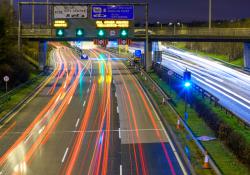
One of the first goals of Mobility as a Service (
The ATL is tasked with approving a cohesive regional transit plan that offers a seamless transportation experience across agencies like the
Travel options
Unlike regional authorities set up in other US cities (which continue to be primarily funded by local taxes), Atlanta’s new structure allows local governments the option of pursuing a transit special local option sales tax.
Last year the City of Atlanta and the State of Georgia also supported ITS International’s MaaS Market conference at which one of the delegates was state employee Merryl Mandus. “As I listened to the presenters, MaaS started to sound appealing,” says Mandus who is general counsel for Georgia’s State Road and Tollway Authority (SRTA), the independent body that operates Georgia’s tolled facilities and acts as its transportation financing arm. SRTA manages Georgia’s Express Lanes, administers the Atlanta region’s vanpool programme and manages the Xpress regional commuter coach transit service.
“I felt that if our mission was to provide mobility options for citizens, then I should try to some extent to ‘walk the walk’ and not just ‘talk the talk’,” she explains. “So I took a serious look at my travel options and in November I got rid of my car. We are now a one-car household. What’s more, we’re saving a lot of money and I’m enjoying the freedom.”
Mandus lives around 12km (7.5 miles) from her office which, fortunately, sits above a Marta station. As her home is 1.5km (one mile) from the nearest Marta station, she uses either a ride-hailing service or is dropped off by her fiancé. “Then I’m on the train and off to work – it’s a pleasure. I still do drive at times and that last mile to work is an absolute pain in the neck – it’s a real problem.”
Cost savings
In terms of travel times, they are roughly equal on the morning commute and can be quicker on the way home. “Because the trains come every 10 minutes at peak times, I don’t pay attention to the timetable. When I finish work, I walk down to the station and if there is a train waiting then I will get home faster than driving. I’m not going to stress about making any particular train and if I’ve just missed one then that extra 10 minutes’ wait evens up the door-to-door travel time. It saves me money and it saves me stress and, in many ways, I feel the stress is more important than the money. When you sit in traffic it not only eats up time but it is stressful and many people don’t realise the stress traffic congestion causes - until they stop doing it.
Taking the transit option also saves her approximately $325 per month. “I have to pay for Marta tickets, occasionally Uber, and there are still costs attached to running the remaining car,” she explains. “But perhaps more importantly, I don’t need to worry about making a car payment, other costs of maintaining a car and I can’t overemphasise the freedom in not having to deal with a car – it’s a pleasure.”
However, while the savings may be edging towards $4,000 per year, financially the case for making the switch is not as overwhelming as it may first appear. “I did the analysis and while I live only a mile away from the station, if I had to take an Uber or Lyft twice a day, it just wouldn’t be worth it and I might as well keep the car. Without the option of ride-hailing, I would not have made this change.”
Does she miss anything about commuting by car? “I did use the time stuck in traffic to make personal phone calls. I don’t get to do that anymore and that’s my big trade-off - but it’s not a bad deal.”
Commuters deterred
What if that journey wasn’t as convenient, would she still use transit? “If I had to take a bus to the Marta station then I probably wouldn’t do it but it does work well for us and our employment situation. Having a train station beneath my office was a huge factor and even if I had to walk a block or so that wouldn’t have deterred me from making the change. However, if at either end it was a couple of miles away from the station, I don’t know if I would have done it.”
What if the trains ran only once an hour, would that deter her from using Marta? She says no - but it would make her more diligent about timekeeping to ensure she caught the chosen service.
With a food store across the street from the Marta station near her home, it is possible to get provisions as and when needed - although for other shopping trips Mandus usually uses the car. She also drives to work if she has a meeting that may run past normal office hours and into the evening – and this typifies the need for confidence in the reliability of transit and security of travellers. Even where services are assured, travelling on shared public services can be intimidating for the young and elderly, lone females and minorities.
“That’s a very real issue,” says Mandus who made a presentation about harassment on public transit to this year’s Transportation Research Board (TRB) meeting. “When I am working and using transit during the day I am definitely not concerned. Marta does a lot to ensure people see the police officers at the stations and there is a ‘See and Say’ programme which has improved the situation enormously. The police were always there but now they wear high- visibility clothing and so you can see them and it is wonderful. However, as I talk to women it is clear that harassment is a real concern.”
Room for improvement
Looking at the broader picture, now that Mandus is experiencing Marta’s services more frequently, are there things that could be improved? “There is always room for improvement in any industry and that’s exactly what the ATL board is focusing on – making transit attractive, including the use of technology to help travellers.”
Initial moves include aligning the technology between all the various mobility agencies so the public have more options than just driving into the city in the general-purpose lanes.
“Personally, I would like the level of convenience I enjoy made available to others – expanding that first/last mile to two miles,” she emphasises. “For Atlanta, building more track is so expensive so I would suggest bus rapid transit [BRT] as the most economical way to go.”
Mandus concludes: “I am thrilled to be a one-car household as it happens to work for us. The challenge ahead is to make it work for a large proportion of citizens in the Atlanta region.”






